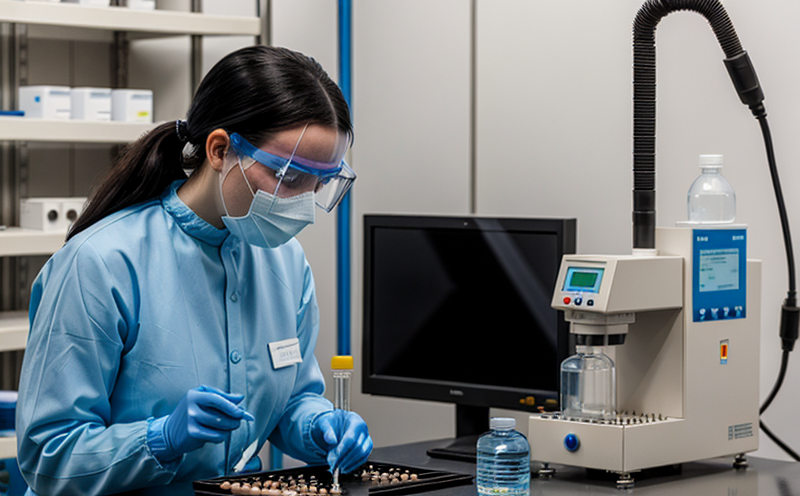EP Organic Impurity Testing
The European Pharmacopoeia (EP) is a collection of monographs and general chapters that provide specifications and methods for testing pharmaceutical substances. Organic impurities are a critical aspect of this, as they can affect the safety, efficacy, and stability of drug products. Our EP Organic Impurity Testing service ensures compliance with the relevant sections of the European Pharmacopoeia.
The process involves identifying, quantifying, and characterizing organic impurities in pharmaceuticals to ensure their quality and safety. This testing is crucial for ensuring that drugs meet the stringent standards set by regulatory bodies like the EMA (European Medicines Agency) and the FDA (Food and Drug Administration).
Our service includes a comprehensive approach to organic impurity testing, which encompasses several key steps:
- Sample Preparation: Proper handling of the sample is critical. This involves dissolution in appropriate solvents followed by filtration.
- Identification and Quantification: Advanced analytical techniques such as High-Performance Liquid Chromatography (HPLC), Gas Chromatography-Mass Spectrometry (GC-MS), and Nuclear Magnetic Resonance (NMR) are used to identify and quantify impurities.
- Characterization: Detailed characterization of the impurities is performed using spectroscopic methods. This includes infrared spectroscopy (IR), nuclear magnetic resonance (NMR), and mass spectrometry (MS).
- Data Interpretation: The data obtained from these analyses are interpreted to determine the nature, origin, and potential impact of the organic impurities.
- Compliance Reporting: A detailed report is prepared that aligns with the European Pharmacopoeia requirements. This includes a summary of all detected impurities, their levels, and any potential risks they pose.
The importance of this testing cannot be overstated in the pharmaceutical industry. Organic impurities can arise from various sources including raw materials, synthetic processes, or degradation during storage. Detecting these impurities early ensures that they do not accumulate to harmful levels, thus protecting patient safety and maintaining product quality.
Scope and Methodology
| Test Procedure | Description |
|---|---|
| HPLC Analysis | Determines the concentration of organic impurities in a sample. This is performed using a variety of detectors including ultraviolet (UV), refractive index (RI), and mass spectrometry (MS). |
| GC-MS Analysis | Identifies unknown compounds by their mass-to-charge ratio. This technique provides both qualitative and quantitative data on organic impurities. |
| NMR Spectroscopy | Provides detailed information about the molecular structure of organic impurities, aiding in their identification. |
| IR Spectroscopy | Used to identify functional groups present in the impurities. This provides additional structural information complementing that from NMR. |
| Acceptance Criteria | Description |
|---|---|
| Total Organic Impurity Limit (TOIL) | The maximum allowable concentration of total organic impurities in a drug substance or product. |
| Specific Organic Impurity Limits (SOIL) | The upper limits for specific known organic impurities, often derived from the synthesis process. |
| Total Declarable Organic Impurities | The sum of all organic impurities that are declared in the product information. |
Benefits
Compliance with the European Pharmacopoeia is essential for pharmaceutical manufacturers. Our EP Organic Impurity Testing service offers several benefits:
- Regulatory Compliance: Ensures that your products meet the stringent requirements of the European Pharmacopoeia.
- Patient Safety: By detecting and quantifying organic impurities early, potential risks to patient health are minimized.
- Quality Assurance: Maintains high standards in your manufacturing processes, ensuring consistent product quality.
- Risk Management: Identifies and manages risks associated with organic impurities, helping you stay ahead of regulatory changes.
- Efficiency: Reduces the time and cost associated with non-compliance by catching issues early in the development process.
- Reputation: Demonstrates your commitment to quality and safety, enhancing your brand reputation in the market.
The European Pharmacopoeia is a respected authority in pharmaceutical standards. By adhering to its requirements through our testing service, you ensure that your products are of the highest quality and meet international standards.
Customer Impact and Satisfaction
Our EP Organic Impurity Testing service has had a significant positive impact on our customers. Here’s how:
- Informed Decision-Making: Our detailed reports provide valuable insights into the organic impurities present in your products, allowing for informed decisions regarding process improvements and quality control.
- Enhanced Product Integrity: By identifying potential issues early, our service helps maintain the integrity of your products from development to market release.
- Improved Efficiency: Our streamlined testing processes reduce the time required to meet regulatory deadlines, thus enhancing overall efficiency.
- Customer Satisfaction: Regular feedback from satisfied clients attests to the quality and reliability of our service. This is a testament to our commitment to excellence in pharmaceutical testing.
We are proud of the positive impact we have on our customers' businesses, ensuring that they can focus on their core activities while trusting us with their quality assurance needs.





